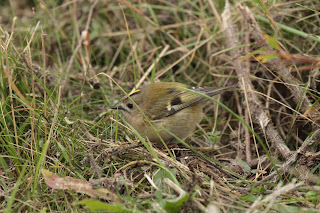October is a month that
every birdwatcher in Britain waits for with great anticipation. It is at a time
when birds from all parts of the World are on the move. Whilst our own familiar
summer breeding birds such as Swallows and House Martins are beginning their
journeys south for a winter south of the Sahara Desert many other less familiar
ones are actually heading our way. From the taiga forests of northern Europe,
thrushes like Redwings and Fieldfares start to arrive while wildfowl and wading
birds such as Pink-footed Geese, Wigeon, Teal, Brent Geese and Dunlin amongst
many others come from the Arctic tundra of Greenland, Iceland and northern
Russia.
The thing that makes North Norfolk so special at this magical time of
year is that it juts out into the North Sea, making it the first landfall for
many migrating birds as they leave Europe. This is where and when Holkham
really comes into its own. Ever since the late 1960s when the study of
migration became more popular, Holkham with its mix of coastal sand dunes and
woodland has always been a place where rare and unusual species have turned up
sometimes amidst huge numbers of commoner migrants. The phenomenon is weather dependant
and first and foremost a prevailing wind from the east or north east is
required. Fine weather on the continent prompts migration and with an easterly
wind behind them, birds are drifted towards the UK instead of south to the
usual wintering grounds. If this is combined with rain over the North Sea the
results can be unbelievable. Hundreds, sometimes thousands of small songbirds
can be grounded by bad weather and amongst the common species such as Robins,
Goldcrests, Blackbirds and Chiffchaffs there will undoubtedly be rarer species.

A newly arrived lost migrant Goldcrest feeding on the
ground on the dunes.
This is what sets the pulse racing of avid birders and what brings them from
all over the UK with high hopes of seeing something unusual. Most regular
amongst the rarities are birds that breed in the birch forests of Siberia and
generally winter in the foothills and lowlands of south east Asia. It is really
an amazing feat that birds such as Yellow-browed and Pallas’s Warblers,
brightly marked songbirds smaller than a Wren can travel all this way.
The tiny but brightly marked Pallas’s Warbler from the forest
of Siberia photographed at Lady Anne’s Drive. (Geof Douglas)
In 1975 when the wind
blew easterly over several weeks an amazing variety of unusual birds made
landfall at Holkham. Britain’s first ever Yellow-browed Bunting was recorded
along with Norfolk’s first ever Olive-backed Pipit, Isabelline Shrike and
Black-throated Thrush. It was such an unprecedented event that at the time it
was described in the respected magazine British Birds as ‘the finest mainland
birdwatching ever experienced in the British Isles’! Whilst such events have
probably not been surpassed there have been years when it has almost been
equalled. The most unusual species recorded surely has to be the Red-breasted
Nuthatch that arrived in October 1989. This tiny Blue Tit sized bird actually
breeds in Northern Canada and the United States and spends the winter in
Central America. Quite how it ended its migration at Holkham remains one of
nature’s great mysteries!
Isabelline Shrike with a male Blackcap beside the
Washington Hide at Holkham.
This year has also been
phenomenal. An amazing selection of Siberian breeding species appeared and over
the weekend of the 18th several hundred birders visited the reserve,
with the Wells end of the Pinewoods attracting birdwatchers from all parts of
the country. The list of species was phenomenal, some have suggested it was a
period close to the legendary days of 1975. Prize of place went to two
Red-flanked Bluetails; one at Holkham, one at Wells. These colourful Robin like
birds nest across Asia from Hokkaido in Japan west to eastern Finland ! Other
exceptional species included Isabelline Shrike near the Washington Hide, an
Olive backed Pipit at Wells, up to 5 Pallas’s Warblers, a Radde’s Warbler, a
Dusky Warbler, a Hume’s Warbler and a Blyth’s Reed Warbler. Heady days indeed
for the visiting birders and a year that will go down in history as being the
one that was almost as good as 1975…..

Similar to a Robin but with a vivid blue tail and red flanks,
the very rare Red-flanked Bluetail.
Andrew Bloomfield, Holkham National Nature Reserve
















